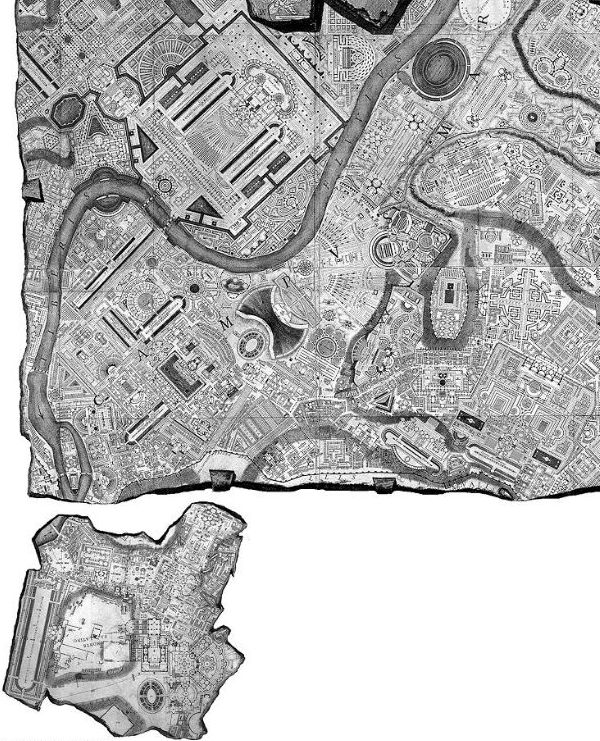Let us examine Piranesi's Collegio once again. As in the Carceri, what at first seems to be the subject is later negated and turned into a supplementary element. The centrality of the composition, with its successive and independent rings, projects outward from the circular space of the grand staircase subdivided into eight flights, which, among the organisms "that are in search of their own role" within the concentric structures, is, significantly, one of the minor spaces. Actually, as one proceeds gradually from the center toward the periphery of the composition, the dimension of the rooms seems to grow progressively larger, while their geometrical structure becomes increasingly more differentiated and articulated. For example, look at the succession of loggias and atriums on the perpendicular axes or, even more revealing, the succession of spaces juxtaposed on the diagonal axes, terminating--at the bottom half of the sheet--in two mixtilinear rooms with a boldly carved-out perimeter.
What differentiates Piranesi's design from the abstract designs "of great dimension," so customary in the eighteenth-century competitions of the Academy of San Luca, is its obvious programmatic character. The "ampio magnifico Collegio" is in fact a structure theoretically endlessly expandable. The independence of the parts and their montage obey no other law than that of pure contiguity. The Collegio, then, constitutes a kind of gigantic question mark on the meaning of architectural composition: the "clarity" of the planimetric choice is subtly eroded by the process with which the various parts engage in mutual dialogue; the single space secretly undermines the laws to which it pretends to subject itself.
In this sense, the Carceri serves to heighten the crisis of the architectural object expressed in the Collegio and of which Piranesi had already given a metaphorical hint in those masterful representations of the twilight of the rococo, the four Capricci (Caprices) of 1744-45. Refuting the hermetic-masonic interpretation of Calvesi, Jonathan Scott has interpreted the Capricci as a reflection of the Arcadian games: of that Arcadia, to be sure, to which Piranesi belonged from 1750--perhaps through the intervention of Bottari--and from which he expected renown and useful contacts.
It has already been pointed out that, in the Carceri, the constriction comes not from the absence of space, but from an opening toward the infinite.
Inasmuch as Piranesi's erudite citations present a whole universe--which includes, as we have seen, the spectator himself--and inasmuch as these citations themselves (as Calvesi and Gavuzzo Stewart have observed) indicate that this universe is both that of republican justice and that of imperial cruelty, we must conclude that the universe of intersubjective domination, of the contrat social, establishes, together with control of "natural" subjectivity, the reign of the most absolute coercion. It is not by accident that the Nature invoked by the Enlightenment to legitimate the domination of the bourgeoisie is represented by Piranesi as a corrosive, diabolical, antihuman element. But even this contestation of a transcendental and providental order of nature is a basic part of Enlightenment criticism. Think, for example, of Hume's Dialogues concerning Natural Religion (published posthumously in 1779), in which the Christian Demea recognizes that "a perpetual war is waged against all living creatures," or Goethe's Werther (1774), where the theme of the "necessity" and "naturalness" of cruelty is dominant, or the Neveu de Rameau, written by Diderot between 1761 and 1774, in which the disharmony between the individual and society is seen as inevitable: "In nature, all the species devour each other; in society, all the classes devour each other." (And we have deliberately overlooked, for the moment, the contrasting and complementary cases of Rousseau and Sade.)
Manfredo Tafuri, The Sphere and the Labyrinth: Avant-Gardes and Architecture from Piranesi to the 1970's (1987), pp.30-1.
| |

2007.08.23 17:03
Name that Architect and Building!!!
Miguel Fisac, Jorba Laboratories, Madrid, 1965-67.
Guess what, this is another on the Transformations. I told you that book was good.
3334t
| |

5320
|

